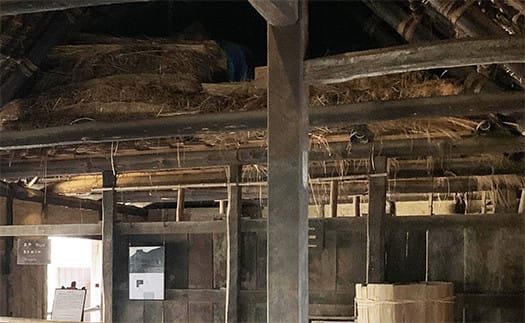


岩手県紫波町にあった古民家「南部曲り家」その7回目。
たくさんの写真で「家を紹介する」というクセが抜けずに
けっこうこれまでは古民家シリーズ、1軒は数回の紹介でしたが、
やはり住宅の探究ブログとしてはいろいろに気付くことがあるので、
ちょっと丹念にテーマを絞りつつ掘り下げ型で書いていこうと考えております。
本日は古民家でよく見かける「小屋裏のカヤ束収納」。
こちらの住宅は川崎市の日本民家園に移築保存展示されているので、
こういった小屋裏のようなディテールについては、移築保存前の状態が
参考にされて展示構成されているものと理解します。
この民家園での他の住宅展示でもこれと同様に小屋裏、屋根裏とも言いますが
そこにカヤ束が収納されている様子を見ることがあります。
こちらの住宅では写真でお分かりのように馬屋の上部に分厚く収納されている。
農家住宅では当然、生産物のコメなどから繊維部分が集積される。
コメの種子部分を茎から取り出すとカヤ束が発生する。
それは農家の夜なべ仕事の典型である藁細工生産の原材料となるでしょう。
それはごく自然な成り行きであろうと思います。
秋の収穫期に大量に集積するこのカヤはある程度「束」にされて
長期保存可能なスペースとして小屋裏に上げられていたことでしょう。
その季節実態を考えると秋、それも晩秋から冬場に掛けて
農家住宅の小屋裏はこのカヤ束に大量ストックされていたのではないか。
晩秋から冬にかけては農家の屋外労働が小休止になるので、
その時期に土間・ニワ部分で藁製品の細工がされていった。
これはごく自然な農家の作業輪廻であっただろうと思います。
で、わたしとしてはその光景がちょうど現代住宅の小屋裏断熱、
グラスウールの「充填」とどうもイメージが重なるのであります。
グラスウールとは割れたガラスなどを繊維状に加工再生したもので
断熱性能が期待できるのは、細かい繊維の空隙に「静止空気」を
たっぷりと保存しているからというのが物理法則。
もし自然素材での「代用」を考えたら、このカヤ状繊維は茎部分に
空気を保存しているのであり、気密は当然不作為だったとしても、
全体として一定の断熱機能は果たせるのではないかと妄想させられる。
しかも収納されるのは晩秋から冬場に掛けてで寒さの季節的整合性も高い。
屋根にカヤを施工するのも雨仕舞と並んでこの性能を期待したと思える。

写真のようにカヤ束のない小屋裏の光景は素寒貧を訴求してくるけれど、
カヤ束がたっぷりとある小屋裏部分は、視覚的にも暖かさが感じられる。
そもそもカヤ類は馬の「寝わら」で寝具の役割も果たしていた。
こういったカヤ束「断熱」についての研究を探しているけれど
たぶん、グラスウールが開発された現代になっては研究目的が成立しないと思われ
目に触れる機会がありません。
しかし、こういった古民家での「生活実感」が人類記憶から消えてしまう前に
科学的にチェックして見ることは有益ではないだろうか?
そんな思いがこうした古民家探訪で頭をよぎり続けています。
English version⬇
[Glass wool-like straw bundle in the back of the hut / Good Japanese house ㉗-7]
The 7th time of the old folk house "Southern Curved House" in Shiwa Town, Iwate Prefecture.
The habit of "introducing a house" is not lost in many photos
So far, I have introduced the old folk house series several times,
After all, as a housing exploration blog, there are many things to notice, so
I'm thinking of writing in a digging style while narrowing down the theme a little carefully.
Today, we often see "Kaya bundle storage in the back of a hut" in an old folk house.
This house has been relocated and preserved and exhibited at the Japanese Folk House Garden in Kawasaki City, so
For details such as the back of the cabin, the state before relocation and preservation is
I understand that the exhibition is organized with reference.
In other housing exhibitions at this private house, it is also called the hut or attic.
You may see a bunch of kaya stored there.
As you can see in the photo, this house is thickly stored in the upper part of the barn.
Naturally, in farm houses, fiber parts are accumulated from rice and other products.
When the seed part of rice is taken out from the stem, a kaya bundle is generated.
It will be the raw material for straw production, which is typical of farmer night pot work.
I think it's a very natural process.
This kaya, which accumulates in large quantities during the autumn harvest season, is bundled to some extent.
It would have been raised in the back of the hut as a space that could be stored for a long time.
Considering the actual situation of the season, autumn, from late autumn to winter
The back of the hut of the farmhouse may have been stocked in large quantities in this bundle of kaya.
From late autumn to winter, the farmer's outdoor work is a short break, so
At that time, straw products were being worked on in the soil and niwa areas.
I think this would have been a very natural farmer's work cycle.
So, for me, the scene is just the insulation behind the cabin of a modern house.
The image overlaps with the "filling" of glass wool.
Glass wool is made by reusing broken glass into fibers.
Insulation performance can be expected by creating "static air" in the voids of fine fibers.
The law of physics is that it is well preserved.
If you think of it as a "substitute" for natural materials, this kaya-like fiber is on the stem.
It preserves air, even if airtightness is of course omission.
I am delusional that a certain heat insulation function can be achieved as a whole.
It seems that the construction of Kaya on the roof expected this performance as well as the rain.
As you can see in the picture, the scene behind the hut without a bunch of kaya appeals to the poor.
The back of the hut, which has plenty of kaya bundles, is visually warm.
In the first place, kaya also played a role as bedding as "sleeping straw" for horses.
I'm looking for research on this kind of Kaya bundle insulation.
Probably, the research purpose will not be established in the present age when glass wool was developed.
I have no chance to see it.
However, before the "feeling of life" in such an old folk house disappears from human memory.
Isn't it useful to check and see scientifically?
Such thoughts continue to graze my head during this kind of exploration of old folk houses.



















